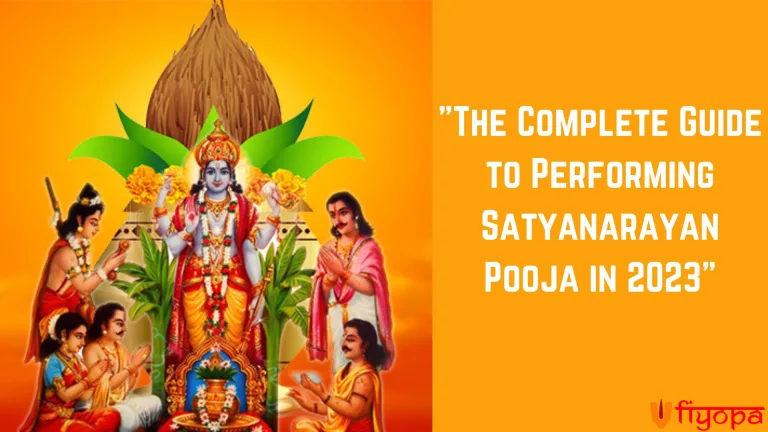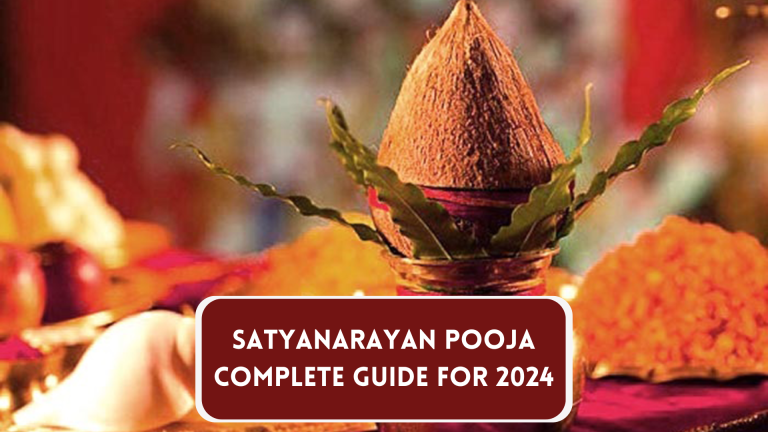Satyanarayan Pooja Complete Guide For 2024 | Checkout
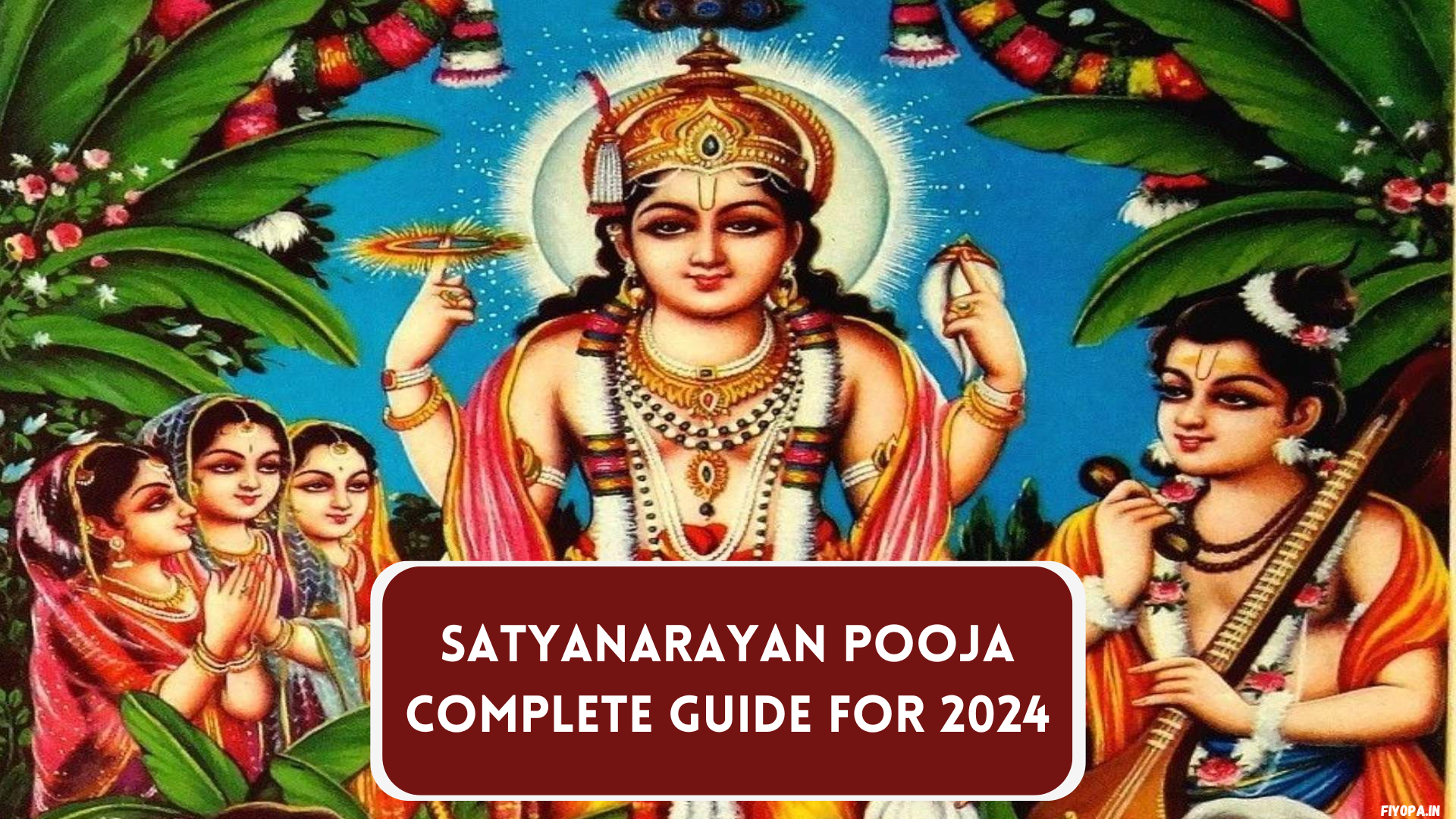
Satyanarayan Pooja is done to please Lord Vishnu, the preserver of the universe. It is a simple ritual suitable for the present time. Lord Vishnu is seen as a kind and gentle form. According to Skanda Purana, Lord Vishnu taught the Satyanarayana Vrat rituals to Maharshi Narad in response to a question on how people can overcome difficulties in the age of Kali Yuga.
Satyanarayan Puja and Katha Paath can be performed on any day for various benefits such as success in ventures, a happy life, and profitable business. It is usually done after auspicious occasions like marriages or moving into a new house. This puja can also be performed for success in business or career growth, during social events like marriages, house-warming ceremonies, anniversaries, naming ceremonies, etc. Overall, it is done to achieve success in life.
Who is Lord Satyanarayana?
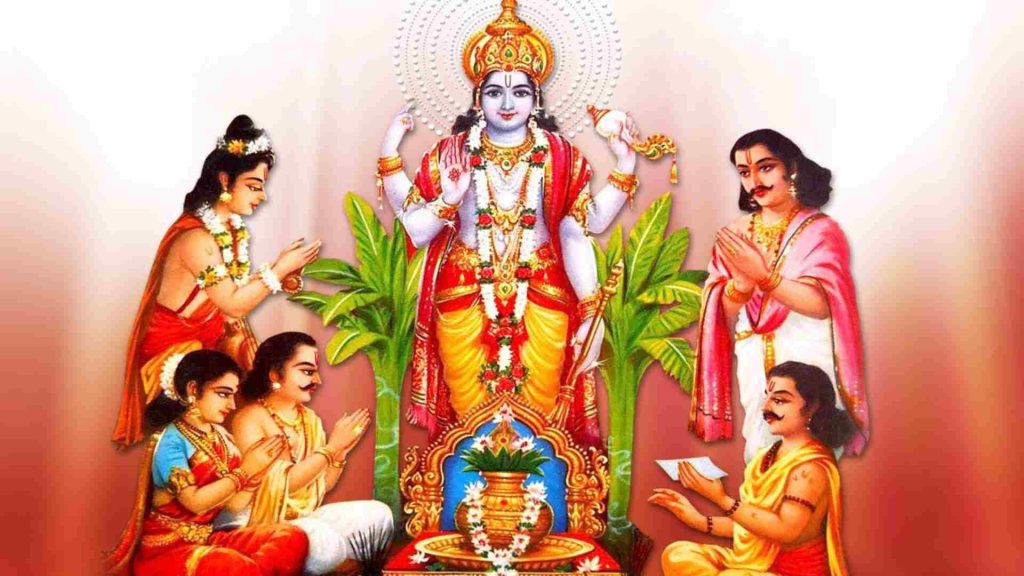
Lord Satyanarayana is a name for the Hindu god Vishnu, known as the preserver and protector in the Hindu trinity. His name means “highest being of truth” in Sanskrit. He is sometimes depicted as Krishna, another avatar of Vishnu. Devotees worship Lord Satyanarayana to seek blessings and success, especially in business and careers. The Satyanarayana Puja is a common ritual worship dedicated to him, performed on various occasions like housewarmings, marriages, and to overcome difficulties.
Satyanarayan Pooja Rituals
- Ganapati Puja
- Sankalp Rituals
- Kalash Sthapana Puja
- Punyahavachan
- Navagraha Puja
- Satyanarayan Puja and Katha Vachan
- Havan
- Purnahuti
- Mahamangal Aarti
- Aashirvachan
- Prasad Vitran etc.
The duration of Puja is approximately 2 hours, and the total cost includes Pandit Ji’s Dakshina, travel expenses, and all necessary Puja items and materials.
Why Satyanarayan Puja is performed?
The Satyanarayan Puja is performed for various reasons, including seeking blessings and cultivating positive qualities.
- To appease Lord Vishnu: Satyanarayana is worshipped as a form of Lord Vishnu, believed to bring blessings and prosperity to those who worship him.
- Forgiveness and overcoming difficulties: The puja is performed with the belief that it can help individuals overcome challenges and hardships caused by past actions or karmic debt. Worshipping the embodiment of truth is seen as a way to seek forgiveness and start anew.
- Promoting Truthfulness: The puja centers around the concept of Satyanarayana, emphasizing the significance of truth. Devotees may participate in the puja to reinforce their dedication to honesty and honesty.
- Family and Unity: The puja can serve as a gathering for friends and family to participate in a shared religious experience, promoting community and building stronger relationships.
- Specific Needs: Followers can conduct the puja for various reasons, such as improving health, ensuring a happy marriage, or achieving success in a new venture.
History And Origins of Satyanarayan Puja
The origins of Satyanarayan Puja are not clear. It is mentioned in the Skanda Purana, a medieval text, but there is a theory that it may have developed more recently. This theory suggests that the puja may have originated from the Hindu-Muslim worship of Satya Pir, a supposed Sufi saint in Bengal in the 16th century.
This possible connection could have been influenced by Mughhal emperor Akbar’s efforts at promoting religious tolerance. Despite its uncertain beginnings, Satyanarayan Puja has become a popular and adaptable ritual in various regions of India.
Satyanarayana Pooja is traditionally performed on a specific day.
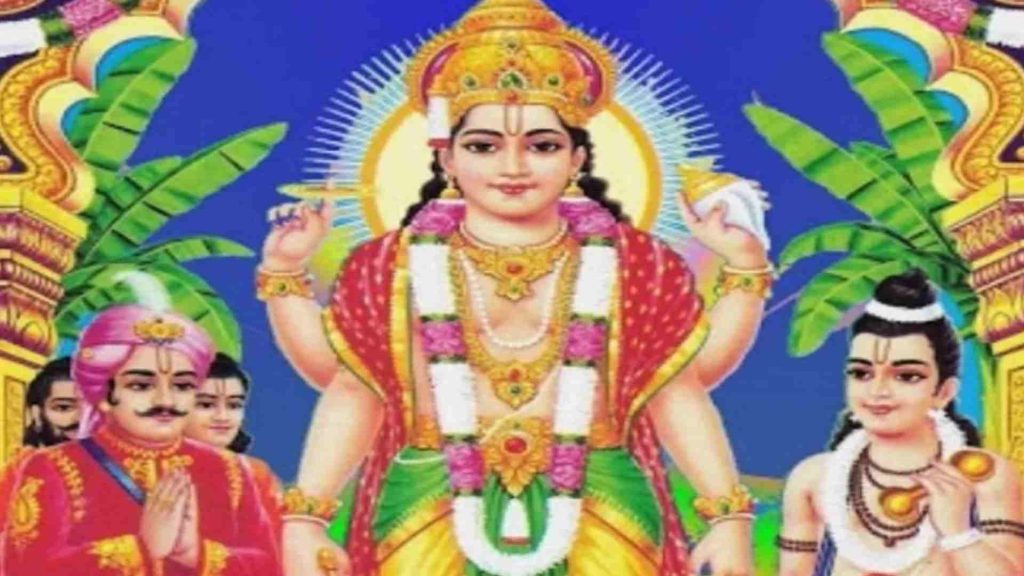
Satyanarayan Pooja does not have a fixed day or date for being performed. Ekadashi tith or Poornima tith is considered auspicious for this pooja. It can be performed in the morning or evening, but performing it in the evening is believed to be more beneficial for veteran pandits.
Satyanarayan Pooja is also performed on various other occasions in addition to the main ritual.
- Griha Pravesh Puja
- Birthdays
- Namakaran Ceremony
- Success in Business
- Beginning of new ventures
- Makar Sankranti
- Marriage Functions
Satyanarayan Pooja Date in 2024
The Satyanarayan Puja can be performed on multiple dates throughout 2024, with certain days considered more auspicious based on their alignment with lunar phases.
- Already passed:
- March 24 (Sunday)
- February 23 (Friday)
- January 24 (Wednesday)
- Upcoming:
- April 23 (Tuesday)
- May 22 (Wednesday)
- June 21 (Friday)
Important Note: Purnima (Full Moon Day) is the most popular day for the puja. For up-to-date information on Purnima dates in 2024, you can refer to an online Hindu calendar or Panchang. or Panchang (https://www.drikpanchang.com/).
Where I Can Perform Satyanarayan Pooja?
The Satyanarayan Puja can be conducted at various locations based on personal preference and available resources.:
- At Home: Many people opt for a home puja ceremony to create a more intimate and personalized experience. This can include setting up a puja space in your home and inviting a Pandit to perform the ceremony.
- Hindu Temple: Hindu temples often have designated areas or times for performing pujas, which can be convenient for those without a suitable space at home or who prefer a more public setting. Contact your local temple for more information on their puja procedures and availability.
- Priest’s Residence: Some Pandits offer to perform puja at people’s residences, which can be a convenient option if finding a suitable temple is challenging.
More Related Puja:- How To Do a Ganesh Puja at Home? Process, Importance & Rituals
Who Should Perform Satyanarayana Pooja?
The Satyanarayan Puja is easily accessible to all individuals, as it does not require specific training or qualifications. Anyone, regardless of caste, gender, age, or marital status, can perform this ritual with devotion, sincerity, and a desire to seek blessings from Lord Satyanarayana.
For individuals unfamiliar with puja procedures or who prefer guidance, a Hindu priest (Pandit) can be invited to conduct the puja. The Pandit will oversee the ceremony, perform rituals accurately, and recite sacred mantras and Katha (holy story) associated with the puja.
List of items required for Satyanarayan Puja.
| One packet of Haldi(turmeric) | One packet of Navadhanyam | One packet of milk |
| One packet of Kumkum | Two bunches of Mango leaves | One small packet of yogurt |
| One packet of cotton wicks | 50 Coins | One bottle of honey |
| One packet of Sandalwood powder | One white towel | 900 grams of Sugar |
| 50 nos of Betel leaves (Paan) | One red, yellow & green cloth | 900 grams of Sooji |
| 50 nos of Betel nuts (supari) | 6 lbs of rice. | One packet of Cashew |
| 50 nos of Raw Haldi | One bottle of Rosewater | One packet of Raisins |
| 50 nos of Dates (Khajoor) | One fresh Flower mala | An Idol of Lord Satyanarayan, Lord Ganesh & Goddess |
| One packet of Incense sticks | 70 flowers (including rose, marigold, hibiscus, etc.) | Utensils |
| One packet of Camphor | One dozen of Banana | Kalash |
| One bottle of coconut oil | Five types of Fruits | Wooden Lamps |
| One tin of Desi Ghee | 7 nos of Dry coconut | Satyanarayan Puja Prasad |
Instructions for performing Satyanarayan Puja in both North Indian and South Indian styles.
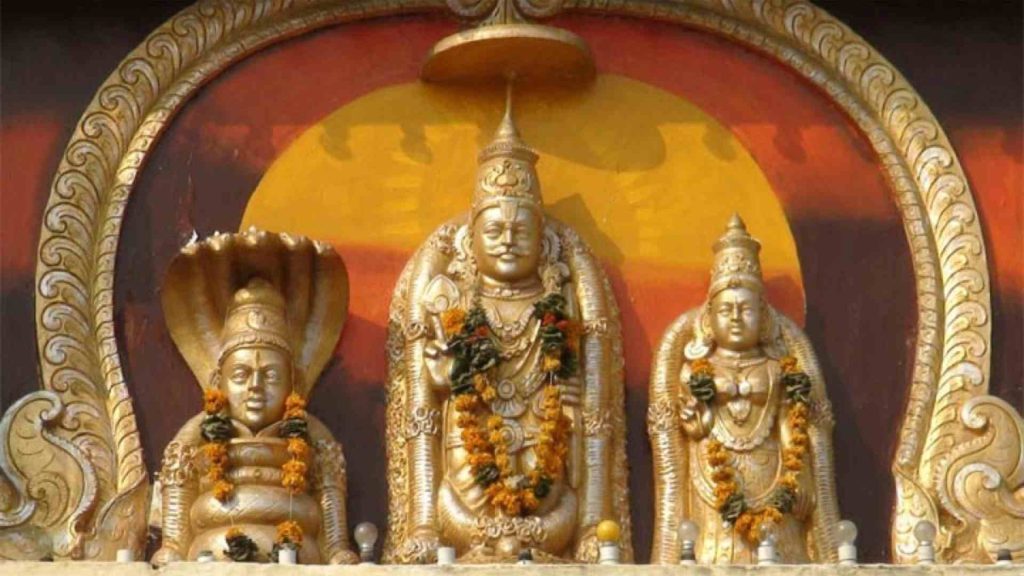
The core purpose and elements of Satyanarayan Puja remain consistent across regions, with slight variations in rituals and offerings between North Indian and South Indian styles.
Common Preparations:
- Cleanse the Puja Area: Purify the space with sacred water (Gangajal) and create a visually appealing atmosphere with a Rangoli (decorative floor art).
- Mandap and Asana: Prepare a platform (Mandap) using banana stems or a clean cloth. Place a wooden seat (Asana) covered with yellow cloth on the Mandap.
- Kalash (Pot): Fill a Kalash with water and place it on the Asana.
- Idol or Image: You can use an idol of Lord Satyanarayana or a picture in his place.
North Indian Style:
- Puja Samagri (Offerings): North Indian puja kits typically include items like roli (vermilion powder), kumkum (red turmeric powder), Chandan (sandalwood paste), betel leaves and nuts, flowers, fruits, sweets (like ladoos or peda), and panchamrit (a sweet mixture of water, honey, ghee, milk, and yogurt).
- Aarti: Aarti (worship with lamps) is performed while offering prayers and hymns dedicated to Lord Satyanarayana.
- Katha: The Katha (holy story) specific to the Satyanarayana Puja is recited.
South Indian Style:
- Puja Samagri (Offerings): South Indian puja kits may include similar items but might also have additions like vibhuti (sacred ash) and turmeric powder. Offerings may include fruits specific to the region and coconut.
- Archana: Archana (ritualistic offering) is performed instead of Aarti, involving chanting mantras while offering flowers, incense, and ghee to the deity.
- Katha: The Katha recitation remains a part of the puja.
General Steps (Common to both styles):
- Sankalpa (Resolution): Declare your intention to perform the puja and seek blessings.
- Asana Pranam (Salutation): Offer reverence to the puja seat as a representation of the divine.
- Panchagavya Snana (Holy Bath): Invoke the five sacred elements (Panchagavya) and symbolically bathe the idol/image.
- Vastra and Abharana (Attire and Ornaments): Offer clothing and ornaments to the deity (symbolically).
- Pushpa and Gandha (Flowers and Fragrance): Offer flowers and incense sticks.
- Naivedya (Food Offering): Present prepared food items and sweets as offerings.
- Aarti/Archana: Perform Aarti (North India) or Archana (South India).
- Katha (Story Recitation): Recite the holy story associated with Lord Satyanarayana.
- Dakshina (Offering to Priest): If a Pandit officiates, offer a Dakshina (honorarium).
- Prasad (Offering Distribution): Distribute the sanctified food (Prasad) to everyone present.
- Mangala Arati (Auspicious Offering): Conclude the puja with a final lamp offering.
Note: These are general guidelines, and specific details might vary depending on family traditions and the guidance from a Pandit (if involved).
More Related Puja:- Tripad Nakshatra Dosha Shanti Puja | Ritual Preparations & Procedure
Looking for a North or South Indian Pandit for a Satyanarayan Pooja?
Performing the Puja with proper rituals and traditions is essential for reaping its benefits. In today’s modern era, it can be challenging for people to remember all the rituals accurately, which is why booking a pandit is a common practice.
Finding an experienced and knowledgeable pandit who can perform Satyanarayan Puja adequately can be challenging due to high demand and hectic schedules in today’s fast-paced world.
Booking through Fiyopa can be a helpful solution for those facing similar issues, as all concerns are taken care of once a booking is made with them.
Conclusion:
The Satyanarayan Pooja is a Hindu ritual dedicated to Lord Vishnu that is believed to offer blessings, help overcome difficulties, and promote truthfulness and prosperity in life. Its adaptable nature allows for its performance on various occasions, reflecting its significance in Hindu culture and spirituality.
FAQs:
Ans: Lord Satyanarayana is a form of Lord Vishnu in Hinduism. People worship him for blessings and success, especially in business and careers. The Satyanarayana Puja is a ritual performed on auspicious occasions to honor him.
Ans: The Satyanarayan Puja is done to seek blessings from Lord Vishnu, overcome challenges, promote honesty, and fulfill specific desires like health, wealth, and success.
Ans: The rituals of Satyanarayan Pooja include Ganapati Puja, Sankalp, Kalash Sthapana Puja, Punyahavachan, Navagraha Puja, Satyanarayan Puja and Katha Vachan, Havan, Purnahuti, Mahamangal Aarti, Aashirvachan, and Prasad Vitran.
Ans: Satyanarayan Pooja can be performed on auspicious days like Ekadashi or Poornima tithi. It is usually conducted after events like marriages or housewarming. Evening ceremonies are considered more beneficial for this ritual.
Ans: Satyanarayan Puja can be done at home, in temples, or at a priest’s place, and is open to all with no special qualifications needed.


